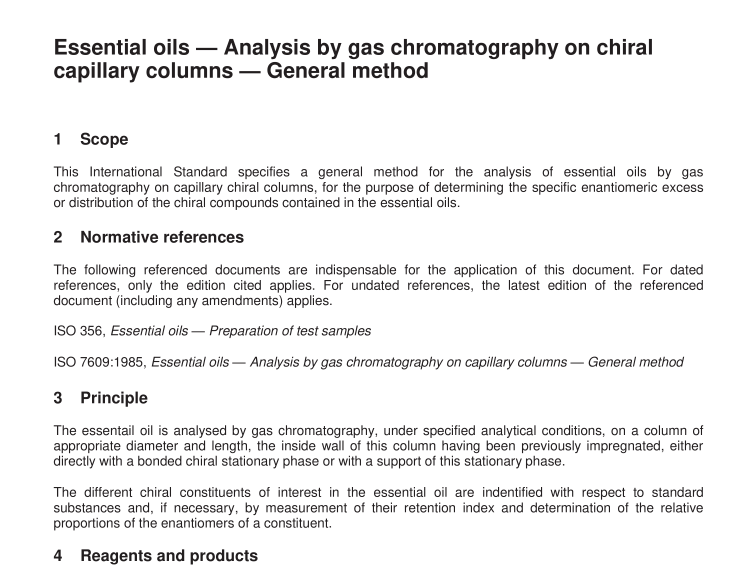BS ISO 22972 pdf download

BS ISO 22972 pdf download Essential oils — Analysis by gas chromatography on chiral capillary columns — General method
Scope
This lnternational Standard specifies a genera method for the analysis of essential oils by gaschromatography on capillary chiral columns, for the purpose of determining the specific enantiomeric excessor distribution of the chiral compounds contained in the essential oils.
2 Normative references
The following referenced documents are indispensable for the application of this document. For datedreferences, only the edition cited applies. For undated references, the latest edition of the reterenceddocument (including any amendments) applies.
ISO 356,Essential oils — Preparation of test samples
ISO 7609:1985, Essential oils 一 Analysis by gas chromatography on capillary columns 一 General method
3 Principle
The essentail oil is analysed by gas chromatography, under specified analytical conditions, on a column ofappropriate diameter and length, the inside wall of this column having been previously impregnated, eitherdirectly with a bonded chiral stationary phase or with a support of this stationary phase
The different chiral constituents of interest in the essential oil are indentified with respect to standardsubstances and, if necessary, by measurement of their retention index and determination of the relativeproportions of the enantiomers of a constituent.
4 Reagents and products
During the course of the analysis, unless otherwise specified, use only reagents of recognized analyticagrade.
4.1Gas.
4.1.1Carrier gas: hydrogen, helium or nitrogen, or any other gas, depending on the type of detector beingused.
if a detector requiring a carrier gas other than those mentioned is used, this should be stated in the test report
4.1.2Detector supply gas: all suitable gases, depending on the detector being used:
for a flame ionization detector, air and hydrogen of high purity;for a mass detector, helium of high purity.
4.2Reference substance, corresponding to the pure and mixed enantiomers to be detected.
5 Apparatus
5.1 Chromatograph, equipped with an injection system, an appropriate detector and a temperature programmer.
The injection and detection systems shall be fitted with devices for independent control of their respective temperatures.
5.2 Capillary column, made of an inert material, having an inner diameter u 0,53 mm and a length between 1 0 m and 60 m.
NOTE Common chiral stationary phases are based on substituted β-cyclodextrins (e.g. 1 ,3,6-permethylated β-cyclodextrin at 1 0 % in OV 1 01 ).
5.3 Recorder and electronic integrator.
6 Preparation of the test sample
See ISO 356.
The test sample may have to undergo the following special preparation:
selective transfer of the relevant constituent(s) (e.g. in-line two-dimensional chromatography or trapping);
derivatization prior to injection.
If it is the case, this will be mentioned in the standard on the relevant essential oil.
7 Operating conditions
7.1 Oven temperature
The oven temperature shall be regulated in such a way as to obtain the required efficiency (see 8.1 ).
7.2 Carrier gas flow rate
The flow rate shall be regulated in such a way as to obtain the required efficiency (see 8.1 ).
7.3 Flow rate of detector supply gases
Refer to the appliance manufacturer’s instructions in order to obtain the optimum response from the detector.
8 Column performance
8.1 Column efficiency
Determine the column efficiency on the less-retained enantiomer of the selected reference substance (see 4.2), according to the method described in ISO 7609.
The efficiency shall be at least 25 000 theoretical plates.









